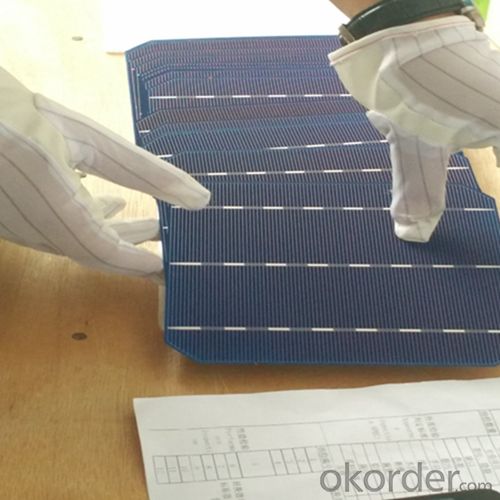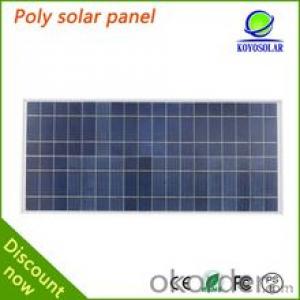Lightest Solar Cells - Poly 156x156mm2 Solar Cells Made in Panels
- Loading Port:
- Shanghai
- Payment Terms:
- TT OR LC
- Min Order Qty:
- 2999 watt
- Supply Capability:
- 6000000 watt/month
OKorder Service Pledge
OKorder Financial Service
You Might Also Like
The operation of a photovoltaic (PV) cell requires 3 basic attributes:
The absorption of light, generating either electron-hole pairs or excitons.
The separation of charge carriers of opposite types.
The separate extraction of those carriers to an external circuit.
In contrast, a solar thermal collector supplies heat by absorbing sunlight, for the purpose of either direct heating or indirect electrical power generation from heat. A "photoelectrolytic cell" (photoelectrochemical cell), on the other hand, refers either to a type of photovoltaic cell (like that developed by Edmond Becquerel and modern dye-sensitized solar cells), or to a device that splits water directly into hydrogen and oxygen using only solar illumination.Characteristic of Mono 156X156MM2 Solar Cells
You are gaining energy independence - add battery backup power for even greater energy security
The cost of electricity is only going to rise – insure against that rising cost
Adaptive cells change their absorption/reflection characteristics depending to respond to environmental conditions. An adaptive material responds to the intensity and angle of incident light. At the part of the cell where the light is most intense, the cell surface changes from reflective to adaptive, allowing the light to penetrate the cell. The other parts of the cell remain reflective increasing the retention of the absorbed light within the cell.[67]
In 2014 a system that combined an adaptive surface with a glass substrate that redirect the absorbed to a light absorber on the edges of the sheet. The system also included an array of fixed lenses/mirrors to concentrate light onto the adaptive surface. As the day continues, the concentrated light moves along the surface of the cell. That surface switches from reflective to adaptive when the light is most concentrated and back to reflective after the light moves along
Mechanical data and design
Format | 156mm x 156mm±0.5mm |
Thickness | 210μm±40μm |
Front(-) | 1.5mm bus bar (silver),blue anti-reflection coating (silicon nitride) |
Back (+) | 2.5mm wide soldering pads (sliver) back surface field (aluminium) |
Temperature Coefficient of Cells
Voc. Temp.coef.%/K | -0.35% |
Isc. Temp.coef .%/K | +0.024%/K |
Pm.Temp.coef. %/K | -0.47%/K |
Electrical Characteristic
Effiency(%) | Pmpp(W) | Umpp(V) | Impp(A) | Uoc(V) | Isc(A) | FF(%) |
18.35 | 4.384 | 0.526 | 8.333 | 0.63 | 8.877 | 78.39% |
18.20 | 4.349 | 0.526 | 8.263 | 0.63 | 8.789 | 78.54% |
18.05 | 4.313 | 0.525 | 8.216 | 0.63 | 8.741 | 78.32% |
17.90 | 4.277 | 0.524 | 8.161 | 0.625 | 8.713 | 78.04% |
17.75 | 4.241 | 0.523 | 8.116 | 0.625 | 8.678 | 77.70% |
17.60 | 4.206 | 0.521 | 8.073 | 0.625 | 8.657 | 77.36% |
17.45 | 4.170 | 0.519 | 8.039 | 0.625 | 8.633 | 76.92% |
17.30 | 4.134 | 0.517 | 8.004 | 0.625 | 8.622 | 76.59% |
17.15 | 4.096 | 0.516 | 7.938 | 0.625 | 8.537 | 76.80% |
17.00 | 4.062 | 0.512 | 7.933 | 0.625 | 8.531 | 76.18% |
16.75 | 4.002 | 0.511 | 7.828 | 0.625 | 8.499 | 75.34% |
16.50 | 3.940 | 0.510 | 7.731 | 0.625 | 8.484 | 74.36% |




 FAQ
FAQ
Q: What price for each watt?
A: It depends on the quantity, delivery date and payment terms, generally Large Quantity and Low Price
Q: What is your size for each module? Can you tell me the Parameter of your module?
A: We have different series of panels in different output, both c-Si and a-Si. Please take the specification sheet for your reference.
Q: What is your size for each module? Can you tell me the Parameter of your module?
A: We have different series of panels in different output, both c-Si and a-Si. Please take the specification sheet for your reference.
- Q: How can the solar power change our life by using solar cells material?
- Because solar power is basically cost-saving compared to the other traditional power/energy generation method.
- Q: What are the maintenance requirements for solar cells?
- The maintenance requirements for solar cells typically include regular cleaning to remove dust and dirt that can reduce their efficiency, as well as occasional inspections to check for any damage or malfunctioning components. Additionally, it is important to ensure that the surrounding vegetation or structures do not shade the solar panels, as this can also affect their performance. Overall, solar cells have minimal maintenance requirements compared to other forms of energy generation.
- Q: How do solar cells affect the electricity grid?
- Solar cells have a positive impact on the electricity grid by reducing the overall demand for electricity from traditional power sources. By generating clean and renewable energy, solar cells contribute to a more sustainable and resilient grid. They help to lower greenhouse gas emissions, decrease dependence on fossil fuels, and promote a decentralized energy system. However, their intermittent nature can pose challenges for grid stability and require the integration of energy storage technologies.
- Q: Can solar cells be used in public charging stations for electric vehicles?
- Yes, solar cells can be used in public charging stations for electric vehicles. By harnessing solar energy, these charging stations can provide clean and renewable power to charge electric vehicles, reducing reliance on traditional grid electricity and contributing to a more sustainable transportation system.
- Q: Can solar cells be used to power medical devices?
- Yes, solar cells can be used to power medical devices. They can convert sunlight into electricity, providing a sustainable and renewable source of power for various medical devices such as portable medical monitors, hearing aids, insulin pumps, and even implantable devices. Solar-powered medical devices are particularly useful in remote or resource-limited areas where access to electricity is limited, ensuring continuous and reliable power supply for critical healthcare needs.
- Q: Can solar cells be used for powering remote weather stations?
- Yes, solar cells can be used for powering remote weather stations. Solar cells convert sunlight into electricity, which can be stored in batteries for use when sunlight is not available. This makes them a reliable and sustainable power source for remote locations where access to the electrical grid may be limited. Additionally, solar cells are low maintenance and can operate for long periods without human intervention, making them an ideal choice for powering weather stations in hard-to-reach areas.
- Q: Can solar cells be used in hotels?
- Yes, solar cells can definitely be used in hotels. Solar panels can be installed on the rooftops or surrounding areas of hotels to harness solar energy and generate electricity. This renewable energy source can help hotels reduce their reliance on traditional power grids, lower their carbon footprint, and save on electricity costs in the long run. Additionally, hotels can also utilize solar power for heating water, lighting outdoor spaces, or charging electric vehicles, further enhancing their sustainability initiatives.
- Q: What materials are commonly used to make solar cells?
- The most commonly used materials to make solar cells are silicon, cadmium telluride, and copper indium gallium selenide.
- Q: Can solar cells be used in agricultural applications?
- Yes, solar cells can be used in agricultural applications. They can be used to power various agricultural equipment such as irrigation systems, greenhouse ventilation, and livestock water pumps. Solar energy can also be harnessed to power remote farms and rural areas, reducing reliance on traditional energy sources and minimizing carbon emissions. Additionally, solar cells can be used to provide electricity for lighting, refrigeration, and other essential services in agricultural facilities.
- Q: Solar cell life for several years
- In physics called solar photovoltaic (Photovoltaic, photo light, voltaics volts, abbreviated as PV), referred to as photovoltaic.
Send your message to us
Lightest Solar Cells - Poly 156x156mm2 Solar Cells Made in Panels
- Loading Port:
- Shanghai
- Payment Terms:
- TT OR LC
- Min Order Qty:
- 2999 watt
- Supply Capability:
- 6000000 watt/month
OKorder Service Pledge
OKorder Financial Service
Similar products
Hot products
Hot Searches
Related keywords



























